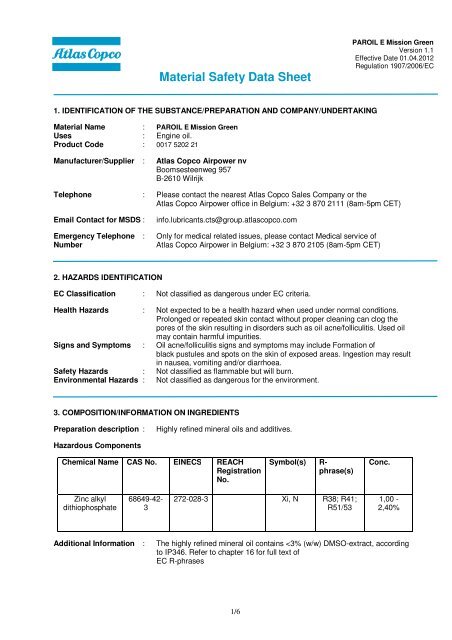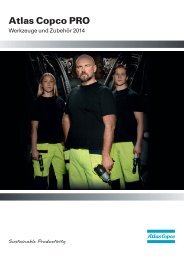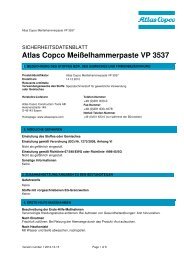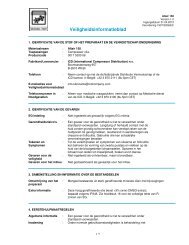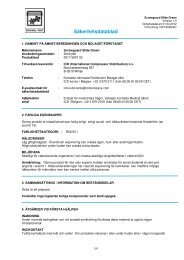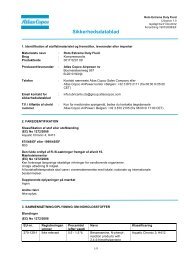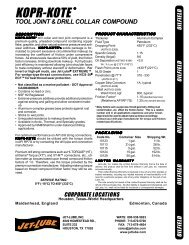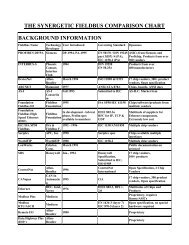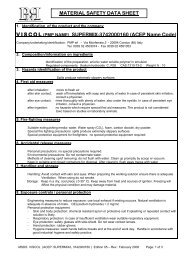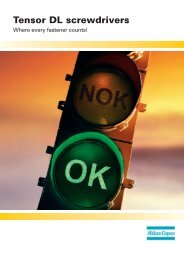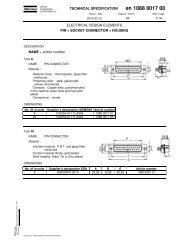Material Safety Data Sheet - Atlas Copco
Material Safety Data Sheet - Atlas Copco
Material Safety Data Sheet - Atlas Copco
You also want an ePaper? Increase the reach of your titles
YUMPU automatically turns print PDFs into web optimized ePapers that Google loves.
<strong>Material</strong> <strong>Safety</strong> <strong>Data</strong> <strong>Sheet</strong><br />
1. IDENTIFICATION OF THE SUBSTANCE/PREPARATION AND COMPANY/UNDERTAKING<br />
<strong>Material</strong> Name : PAROIL E Mission Green<br />
Uses : Engine oil.<br />
Product Code : 0017 5202 21<br />
Manufacturer/Supplier : <strong>Atlas</strong> <strong>Copco</strong> Airpower nv<br />
Boomsesteenweg 957<br />
B-2610 Wilrijk<br />
1/6<br />
PAROIL E Mission Green<br />
Version 1.1<br />
Effective Date 01.04.2012<br />
Regulation 1907/2006/EC<br />
Telephone : Please contact the nearest <strong>Atlas</strong> <strong>Copco</strong> Sales Company or the<br />
<strong>Atlas</strong> <strong>Copco</strong> Airpower office in Belgium: +32 3 870 2111 (8am-5pm CET)<br />
Email Contact for MSDS : info.lubricants.cts@group.atlascopco.com<br />
Emergency Telephone : Only for medical related issues, please contact Medical service of<br />
Number <strong>Atlas</strong> <strong>Copco</strong> Airpower in Belgium: +32 3 870 2105 (8am-5pm CET)<br />
2. HAZARDS IDENTIFICATION<br />
EC Classification : Not classified as dangerous under EC criteria.<br />
Health Hazards : Not expected to be a health hazard when used under normal conditions.<br />
Prolonged or repeated skin contact without proper cleaning can clog the<br />
pores of the skin resulting in disorders such as oil acne/folliculitis. Used oil<br />
may contain harmful impurities.<br />
Signs and Symptoms : Oil acne/folliculitis signs and symptoms may include Formation of<br />
black pustules and spots on the skin of exposed areas. Ingestion may result<br />
in nausea, vomiting and/or diarrhoea.<br />
<strong>Safety</strong> Hazards : Not classified as flammable but will burn.<br />
Environmental Hazards : Not classified as dangerous for the environment.<br />
3. COMPOSITION/INFORMATION ON INGREDIENTS<br />
Preparation description : Highly refined mineral oils and additives.<br />
Hazardous Components<br />
Chemical Name CAS No. EINECS REACH<br />
Registration<br />
No.<br />
Zinc alkyl<br />
dithiophosphate<br />
68649-42-<br />
3<br />
272-028-3<br />
Symbol(s) Rphrase(s)<br />
Xi, N R38; R41;<br />
R51/53<br />
Conc.<br />
1,00 -<br />
2,40%<br />
Additional Information : The highly refined mineral oil contains
4. FIRST AID MEASURES<br />
<strong>Material</strong> <strong>Safety</strong> <strong>Data</strong> <strong>Sheet</strong><br />
2/6<br />
PAROIL E Mission Green<br />
Version 1.1<br />
Effective Date 01.04.2012<br />
Regulation 1907/2006/EC<br />
General Information : Not expected to be a health hazard when used under normal conditions.<br />
Inhalation : No treatment necessary under normal conditions of use. If symptoms persist,<br />
obtain medical advice.<br />
Skin Contact : Remove contaminated clothing. Flush exposed area with water and follow by<br />
washing with soap if available. If persistent irritation occurs, obtain medical<br />
attention.<br />
Eye Contact : Flush eye with copious quantities of water. If persistent irritation occurs,<br />
obtain medical attention.<br />
Ingestion : In general no treatment is necessary unless large quantities are swallowed,<br />
however, get medical advice.<br />
Advice to Physician : Treat symptomatically.<br />
5. FIRE FIGHTING MEASURES<br />
Clear fire area of all non-emergency personnel.<br />
Specific Hazards : Hazardous combustion products may include: A complex mixture of<br />
airborne solid and liquid particulates and gases (smoke). Carbon monoxide.<br />
Unidentified organic and inorganic compounds.<br />
Suitable Extinguishing : Foam, water spray or fog. Dry chemical powder, carbon dioxide, sand or<br />
Media earth may be used for small fires only.<br />
Unsuitable Extinguishing: Do not use water in a jet.<br />
Media<br />
Protective Equipment : Proper protective equipment including breathing apparatus<br />
For Firefighters must be worn when approaching a fire in a confined space.<br />
6. ACCIDENTAL RELEASE MEASURES<br />
Avoid contact with spilled or released material. For guidance on selection of personal protective<br />
equipment see Chapter 8 of this <strong>Material</strong> <strong>Safety</strong> <strong>Data</strong> <strong>Sheet</strong>. See Chapter 13 for information on<br />
disposal. Observe all relevant local and international regulations.<br />
Protective measures : Avoid contact with skin and eyes. Use appropriate containment to avoid<br />
environmental contamination. Prevent from spreading or entering drains,<br />
ditches or rivers by using sand, earth, or other appropriate barriers.<br />
Clean Up Methods : Slippery when spilt. Avoid accidents, clean up immediately. Prevent from<br />
spreading by making a barrier with sand, earth or other containment material.<br />
Reclaim liquid directly or in an absorbent. Soak up residue with an absorbent<br />
such as clay, sand or other suitable material and dispose of properly.<br />
Additional Advice : Local authorities should be advised if significant spillages<br />
cannot be contained.<br />
7. HANDLING AND STORAGE<br />
General Precautions : Use local exhaust ventilation if there is risk of inhalation of vapours, mists or<br />
aerosols. Properly dispose of any contaminated rags or cleaning materials in<br />
order to prevent fires. Use the information in this data sheet as input to a risk<br />
assessment of local circumstances to help determine appropriate controls for<br />
safe handling, storage and disposal of this material.
<strong>Material</strong> <strong>Safety</strong> <strong>Data</strong> <strong>Sheet</strong><br />
3/6<br />
PAROIL E Mission Green<br />
Version 1.1<br />
Effective Date 01.04.2012<br />
Regulation 1907/2006/EC<br />
Handling : Avoid prolonged or repeated contact with skin. Avoid Inhaling vapour and/or<br />
mists. When handling product in drums, safety footwear should be worn and<br />
proper handling equipment should be used.<br />
Storage : Keep container tightly closed and in a cool, well-ventilated place. Use<br />
properly labelled and closeable containers. Storage Temperature: 0 50°C / 32<br />
- 122°F<br />
Recommended <strong>Material</strong>s: For containers or container linings, use mild steel or high density<br />
polyethylene.<br />
Unsuitable <strong>Material</strong>s : PVC.<br />
Additional Information : Polyethylene containers should not be exposed to high<br />
temperatures because of possible risk of distortion.<br />
8. EXPOSURE CONTROLS/PERSONAL PROTECTION<br />
If the American Conference of Governmental Industrial Hygienists (ACGIH) value is provided on<br />
this document, it is provided for information only.<br />
Occupational Exposure Limits<br />
<strong>Material</strong> Source Type ppm mg/m3 Notation<br />
Oil mist, OEL (BE) TWA<br />
5 mg/m3<br />
mineral<br />
[Mist.]<br />
OEL (BE) STEL<br />
[Mist.]<br />
10 mg/m3<br />
ACGIH TWA<br />
[Inhalable<br />
fraction.]<br />
5 mg/m3<br />
Exposure Controls : The level of protection and types of controls necessary will vary depending<br />
upon potential exposure conditions. Select controls based on a risk<br />
assessment of local circumstances. Appropriate measures include: Adequate<br />
ventilation to control airborne concentrations. Where material is heated,<br />
sprayed or mist formed, there is greater potential for airborne concentrations<br />
to be generated.<br />
Personal Protective : Personal protective equipment (PPE) should meet recommended national<br />
Equipment standards. Check with PPE suppliers.<br />
Respiratory Protection : No respiratory protection is ordinarily required under normal conditions of<br />
use. In accordance with good industrial hygiene practices, precautions should<br />
be taken to avoid breathing of material. If engineering controls do not<br />
maintain airborne concentrations to a level which is adequate to protect<br />
worker health, select respiratory protection equipment suitable for the<br />
specific conditions of use and meeting relevant legislation. Check with<br />
respiratory protective equipment suppliers. Where air-filtering respirators are<br />
suitable, select an appropriate combination of mask and filter. Select a filter<br />
suitable for combined particulate/organic gases and vapours [boiling point<br />
>65 °C (149 °F)] meeting EN14387.<br />
Hand Protection : Where hand contact with the product may occur the use of gloves approved<br />
to relevant standards (e.g. Europe: EN374, US: F739) made from the<br />
following materials may provide suitable chemical protection: PVC, neoprene<br />
or nitrile rubber gloves. Suitability and durability of a glove is dependent on<br />
usage, e.g. frequency and duration of contact, chemical resistance of glove<br />
material, glove thickness, dexterity. Always seek advice from glove suppliers.<br />
Contaminated gloves should be replaced. Personal hygiene is a key element<br />
of effective hand care. Gloves must only be worn on clean hands. After using<br />
gloves, hands should be washed and dried thoroughly. Application of a nonperfumed<br />
moisturizer is recommended.
<strong>Material</strong> <strong>Safety</strong> <strong>Data</strong> <strong>Sheet</strong><br />
4/6<br />
PAROIL E Mission Green<br />
Version 1.1<br />
Effective Date 01.04.2012<br />
Regulation 1907/2006/EC<br />
Eye Protection : Wear safety glasses or full face shield if splashes are likely to<br />
occur. Approved to EU Standard EN166.<br />
Protective Clothing : Skin protection not ordinarily required beyond standard Issue work clothes.<br />
Monitoring Methods : Monitoring of the concentration of substances in the breathing zone of<br />
workers or in the general workplace may be required to confirm compliance<br />
with an OEL and adequacy of exposure controls. For some substances<br />
biological monitoring may also be appropriate.<br />
Environmental Exposure: Minimise release to the environment. An environmental<br />
Controls assessment must be made to ensure compliance with local environmental<br />
legislation.<br />
9. PHYSICAL AND CHEMICAL PROPERTIES<br />
Appearance : Amber. Liquid at room temperature.<br />
Odour : Slight hydrocarbon.<br />
pH : Not applicable.<br />
Initial Boiling Point and : > 280 °C / 536 °F estimated value(s)<br />
Boiling Range<br />
Pour point : Typical -33 °C / -27 °F<br />
Flash point : Typical 227 °C / 441 °F (COC)<br />
Upper /lower Flammability : Typical 1 - 10 %(V) (based on mineral oil)<br />
or Explosion limits<br />
Auto-ignition temperature : > 320 °C / 608 °F<br />
Vapour pressure : < 0,5 Pa at 20 °C / 68 °F (estimated value(s))<br />
Density : Typical 883 kg/m3 at 15 °C / 59 °F<br />
Water solubility : Negligible.<br />
n-octanol/water partition : > 6 (based on information on similar products)<br />
coefficient (log Pow)<br />
Kinematic viscosity : Typical 118 mm2/s at 40 °C / 104 °F<br />
Vapour density (air=1) : > 1 (estimated value(s))<br />
Evaporation rate : <strong>Data</strong> not available<br />
(nBuAc=1)<br />
10. STABILITY AND REACTIVITY<br />
Stability : Stable.<br />
Conditions to Avoid : Extremes of temperature and direct sunlight.<br />
<strong>Material</strong>s to Avoid : Strong oxidising agents.<br />
Hazardous : Hazardous decomposition products are not expected to<br />
Decomposition Products: Form during normal storage.<br />
11.TOXICOLOGICAL INFORMATION<br />
Basis for Assessment : Information given is based on data on the components and the<br />
toxicology of similar products.<br />
Acute Oral Toxicity : Expected to be of low toxicity: LD50 > 5000 mg/kg Rat<br />
Acute Dermal Toxicity : Expected to be of low toxicity: LD50 > 5000 mg/kg Rabbit<br />
Acute Inhalation : Not considered to be an inhalation hazard under normal<br />
Toxicity conditions of use.<br />
Skin Irritation : Expected to be slightly irritating. Prolonged or repeated skin contact without<br />
proper cleaning can clog the pores of the skin resulting in disorders such as<br />
oil acne/folliculitis.
<strong>Material</strong> <strong>Safety</strong> <strong>Data</strong> <strong>Sheet</strong><br />
5/6<br />
PAROIL E Mission Green<br />
Version 1.1<br />
Effective Date 01.04.2012<br />
Regulation 1907/2006/EC<br />
Eye Irritation : Expected to be slightly irritating.<br />
Respiratory Irritation : Inhalation of vapours or mists may cause irritation.<br />
Sensitisation : Not expected to be a skin sensitiser.<br />
Repeated Dose Toxicity : Not expected to be a hazard.<br />
Mutagenicity : Not considered a mutagenic hazard.<br />
Carcinogenicity : Product contains mineral oils of types shown to be non carcinogenic in<br />
animal skin-painting studies. Highly refined mineral oils are not classified as<br />
carcinogenic by the International Agency for Research on Cancer (IARC).<br />
Other components are not known to be associated with carcinogenic effects.<br />
Reproductive and : Not expected to be a hazard.<br />
Developmental Toxicity<br />
Additional Information : Used oils may contain harmful impurities that have accumulated during use.<br />
the concentration of such impurities will depend on use and they may present<br />
risks to health and the environment on disposal. ALL used oil should be<br />
handled with caution and skin contact avoided as far as possible. Continuous<br />
contact with used engine oils has caused skin cancer in animal tests.<br />
12. ECOLOGICAL INFORMATION<br />
Ecotoxicological data have not been determined specifically for this product. Information given is<br />
based on a knowledge of the components and the ecotoxicology of similar products.<br />
Acute Toxicity : Poorly soluble mixture. May cause physical fouling of aquatic organisms.<br />
expected to be practically non toxic: LL/EL/IL50 > 100 mg/l (to aquatic<br />
organisms) (LL/EL50 expressed as the nominal amount of product required<br />
to prepare aqueous test (extract). Mineral oil is not expected to cause any<br />
chronic effects to aquatic organisms at concentrations less than 1 mg/l.<br />
Mobility : Liquid under most environmental conditions. Floats on water. If it enters soil,<br />
it will adsorb to soil particles and will not be mobile.<br />
Persistence/ : Expected to be not readily biodegradable. Major constituents are expected to<br />
degradability be inherently biodegradable, but the product contains components that may<br />
persist in the environment.<br />
Bioaccumulation : Contains components with the potential to bioaccumulate.<br />
Other Adverse Effects : Product is a mixture of non-volatile components, which are not expected to<br />
be released to air in any significant quantities. Not expected to have ozone<br />
depletion potential, photochemical ozone creation potential or global warming<br />
potential.<br />
13. DISPOSAL CONSIDERATIONS<br />
<strong>Material</strong> Disposal : Recover or recycle if possible. It is the responsibility of the waste generator<br />
to determine the toxicity and physical properties of the material generated to<br />
determine the proper waste classification and disposal methods in<br />
compliance with applicable regulations. Do not dispose into the environment.<br />
in drains or in water courses.<br />
Container Disposal : Dispose in accordance with prevailing regulations, preferably to a recognised<br />
collector or contractor. The competence of the collector or contractor should<br />
be established beforehand.<br />
Local Legislation : Disposal should be in accordance with applicable regional, national, and local<br />
laws and regulations. EU Waste Disposal Code (EWC): 13 02 05 mineralbased<br />
non chlorinated engine, gear and lubricating oils. Classification of<br />
waste is always the responsibility of the end user.
14. TRANSPORT INFORMATION<br />
<strong>Material</strong> <strong>Safety</strong> <strong>Data</strong> <strong>Sheet</strong><br />
ADR<br />
This material is not classified as dangerous under ADR regulations.<br />
RID<br />
This material is not classified as dangerous under RID regulations.<br />
ADN<br />
This material is not classified as dangerous under ADNR regulations.<br />
IMDG<br />
This material is not classified as dangerous under IMDG regulations.<br />
IATA (Country variations may apply)<br />
This material is either not classified as dangerous under IATA regulations or needs to follow<br />
country specific requirements<br />
15. REGULATORY INFORMATION<br />
The regulatory information is not intended to be comprehensive. Other regulations may apply to this<br />
material.<br />
EC Classification : Not classified as dangerous under EC criteria.<br />
EC Symbols : No Hazard Symbol required<br />
EC Risk Phrases : Not classified.<br />
EC <strong>Safety</strong> Phrases : Not classified.<br />
Chemical Inventory Status<br />
EINECS : All components listed or polymer exempt.<br />
TSCA : All components listed.<br />
16. OTHER INFORMATION<br />
6/6<br />
PAROIL E Mission Green<br />
Version 1.1<br />
Effective Date 01.04.2012<br />
Regulation 1907/2006/EC<br />
R-phrase(s) : Not Classified.<br />
R38 : Irritating to skin.<br />
R41 : Risk of serious damage to eyes.<br />
R51/53 : Toxic to aquatic organisms, may cause long-term adverse effects in the<br />
aquatic Environment.<br />
MSDS Version Number : 1.1<br />
MSDS Effective Date : 01.04.2012<br />
MSDS Revisions : A vertical bar (|) in the left margin indicates an amendment from the<br />
previous version.<br />
MSDS Regulation : Regulation 1907/2006/EC<br />
MSDS Distribution : The information in this document should be made available to<br />
all who may handle the product.<br />
Disclaimer : This information is based on our current knowledge and is intended to<br />
describe the product for the purposes of health, safety and environmental<br />
requirements only. It should not therefore be construed as guaranteeing any<br />
specific property of the product.


